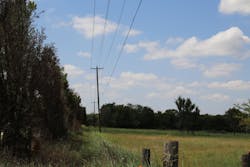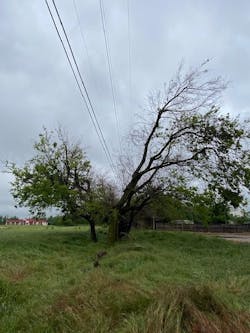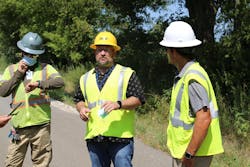When it comes to Integrated Vegetation Management (IVM), the name of the game is continuous improvement. From brush control and environmental sustainability to budget management and landowner relations, numerous factors can impact the success of utility vegetation management programs. Fortunately, utility companies can apply IVM strategies to continuously improve each of these components without sacrificing results or jeopardizing electrical service reliability.
Oklahoma Gas & Electric (OG&E) has used IVM practices since 2019 to enhance mechanical mowing results and mitigate prevalent threats to transmission and distribution infrastructure throughout the utility’s 30,000 square-mile service territory. Strategies associated with this progressive approach have included:
- High-volume foliar herbicide applications to reclaim areas filled with dense and incompatible brush species
- Ultra-low volume wire zone spray trimming and chemical side-trim applications to selectively control limbs or sections of trees posing a threat to service reliability
- Tree growth regulator applications to control regrowth on trimmed trees
- Bareground herbicide applications to control all vegetation on substations, including persistent thistle species
- Tree trimming to control overhanging limbs on rural sites and portions of trees in heavy urban settings or customer-sensitive areas
Enhancing Year-Round Results
Over the past four years, OG&E has used IVM strategies to safeguard the integrity of transmission and distribution infrastructure as well as the utility’s pocketbook. While foliar-season work has played a significant role in the program’s success, dormant-season applications also have delivered a phenomenal return on investment for OG&E. Following each foliar season, applicators work from late fall to early spring using low-volume basal bark, cut-stump and cut-stubble treatments to enhance the future control of brush-sized tree species.
“We’re able to cover thousands of miles during the dormant season,” Huff said. “We’re talking tens of thousands of stems that are now controlled and no longer a problem for us. We’ve had zero complaints with our dormant-season work, and we’re able to treat at a very low cost per mile. We just can’t get that with the tree crews.”
Embracing a Grass-Friendly Approach
Using a combination of dormant- and foliar-season application methods to improve brush control helps OG&E not only eliminate immediate threats to utility infrastructure, but also support the development of beneficial grasses and forbs.
“IVM is a system of land management processes for establishing compatible plant communities,” said Darrell Russell, Market Development Specialist, Corteva Agriscience. “While mowing exclusively can impede native plant development, targeted applications of selective herbicides support this desirable vegetation by selectively controlling incompatible trees and brush species. This ‘grass-friendly’ approach creates landscapes in which beneficial grasses and forbs can thrive.”
Grass-friendly brush mixes have improved results and productivity for OG&E. By preventing woody plant seed germination, the utility has provided habitat for small mammals that consume the seeds of incompatible brush species. These results are consistent with findings generated by decades of environmental right-of-way (ROW) research on State Game Lands 33 (SGL 33) in central Pennsylvania. SGL 33 results indicate that using selective brush mixes as part of an IVM-based approach can successfully lower viable woody plant seed germination by as much as 88%.
As a long-time funding partner of SGL 33 research, Corteva Agriscience helps utility companies and their vegetation management partners apply IVM strategies to support the development of sustainable landscapes throughout utility ROW. Grass-friendly applications and other IVM-based practices can help native plant communities thrive, which is why vegetation management specialists with Corteva have helped OG&E identify chemistries and selective tank mixes that support environmental sustainability. Most recently, the following recommendations have helped contract applicators improve results in the field:
- Chemical side-trim applications featuring tank mixes containing TerraVue® and Vastlan® herbicides from Corteva
- Basal bark and cut-stump applications in the dormant season using Garlon® 4 Ultra herbicide from Corteva
“The foundational mix for grass-friendly selective brush mixes was previously a mixture of Vastlan and Milestone herbicides from Corteva,” Russell said. “However, the registration of TerraVue has added enhanced control of certain woody species, which has resulted in TerraVue and Vastlan being the preeminent mix for selective brush management.”
Improving Public Perception
In the early 1990s, herbicide applications helped OG&E enhance the control of undesirable woody plants. However, the formulations and treatment methods used to support these strategies at the time were far less selective than they are today. As a result, OG&E periodically encountered off-target control issues more commonly caused by mechanical mowing and other nonselective control strategies.
Now backed by the efficacy and efficiency of a more selective approach to brush control, OG&E pays for contractors to go through training and learn more about the chemistries and application strategies they’re asked to use. These educational opportunities have improved not only the selective control of incompatible trees, such as hackberries, elms, mulberries and oak species, but also landowner relations.
“We’re able to get ahead of public concerns by simply educating our partners on the products and strategies we want them to use,” Huff said. “Our applicators also are well-educated on tank mixes, which allows them to talk through landowner concerns. People just want more information. Once we provide it to them, they’re usually more comfortable with what we’re doing.”
These conversations are further supported by the visual results of a grass-friendly approach. While landowners may not always agree with controlling undesirable trees on their property, Huff notes that minimizing off-target control issues has enhanced public understanding of the benefits selective herbicide applications provide.
“When they understand our thought process and see that the grass is still there the following year, it makes a huge difference,” Huff said. “It’s hard to stand there when everything’s browned-out and we can’t say that we didn’t hurt the grass. Thanks to the herbicide treatments we’re using now, we’ve gotten a lot better at handling those types of complaints.”
Supporting Biodiversity
IVM strategies also support long-standing biodiversity initiatives developed by OG&E, which aim to enhance biodiverse habitat development for native wildlife species. For example, representatives with the state of Oklahoma recently found the frosted elfin butterfly (Callophrys irus) among wild indigo on one of the utility’s solar farms. Shortly thereafter, OG&E used selective herbicide applications to help control incompatible vegetation throughout the site before planting more wild indigo in support of habitat development for the endangered pollinator species.
“After finding a new colony that nobody knew existed, we disturbed the environment the least amount possible,” Huff said. “The frosted elfin butterfly benefited from that greatly, and it solidified with our environmental group that we’re approaching vegetation management the right way.”
For more information on IVM strategies and successful herbicide programs that help utility companies and their vegetation management partners improve cost efficiency and environmental sustainability, visit HabitatWithHerbicides.com.
™ ® Trademarks of Corteva Agriscience and its affiliated companies. Under normal field conditions, TerraVue® is nonvolatile. Milestone® and TerraVue have no grazing or haying restrictions for any class of livestock, including lactating dairy cows, horses (including lactating mares) and meat animals prior to slaughter. Label precautions apply to forage treated with Milestone or TerraVue and to manure and urine from animals that have consumed treated forage. Consult the label for full details. Milestone, TerraVue and Vastlan® are not registered for sale or use in all states. Contact your state pesticide regulatory agency to determine if a product is registered for sale or use in your state. State restrictions on the sale and use of Garlon® 4 Ultra apply. Consult the label before purchase or use for full details. Always read and follow label directions.
Sponsored By:



